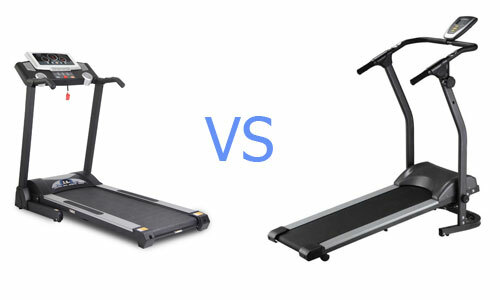Which track is better: electric or magnetic? These two types have a number of differences that can not be neglected when choosing a specific model.

Magnetic treadmill
Magnetic treadmills occupy an intermediate position between mechanical and electric, but with a pronounced approximation to the first. Their main( and only) difference from mechanical simulators is the presence of a smooth running system. This effect is achieved by means of a magnetic flywheel mounted on the side of one of the ends of the upper roller of the moving web.
Advantages:
- compact: small dimensions of the magnetic treadmill allow installing them even in a small-sized apartment;
- low cost;
- efficiency: the drive is not electric power, but the muscles of the user;
- the ability to set the pace of movement of the canvas in a natural way - as far as you can, exercising at such a speed and "running";
- smooth running, somewhat comparable to electric treadmills.
Disadvantages:
Despite the use of a smooth-running system, most of the shortcomings of mechanical tracks migrated to the design of magnetic:
- , the more speed the user wants to develop, the greater effort he has to apply to accelerate the track canvas. At the same time, there is an increase in the load not only on the muscles( which is actually the purpose of training), but also on the spine and joints. This fact serves as an excuse for prohibiting the use of the simulator for people who have problems with the musculoskeletal system;
- magnetic treadmill can not have any additional functions: no special programs are out of the question;
- light and easy running on a magnetic track is only available to users with well-developed leg muscles. Untrained people will "walk" for a long time, until they lose muscle.
Electric treadmills
In electric simulators, the blade is driven by an electric motor. This design feature leads to a number of advantages over magnetic treadmills:
- eliminates the additional load on the joints and spine of the treadmill;
- blade moves more smoothly compared to mechanical models;
- it is possible to equip the simulator with a computer, through which parameters such as the heart rate( pulse), the distance traveled, the number of calories expended are monitored. In addition, special training programs are laid.
- trainer can choose the training mode he needs:
- for weight loss;
- for maintenance of the general or common tonus;
- for the development of endurance of the body, etc.
Disadvantages:
- electric treadmills are more expensive than magnetic ones;
- maintenance and repair of simulators of this type are more costly;
- track dimensions do not allow to install it in small apartments;
- consumes electricity during training;
- as well as any equipment that has an electric drive, this type of racetracks are traumatic.
Based on the above, choose a treadmill, focusing on three components: the state of health, the size of the apartment and the thickness of the purse.



